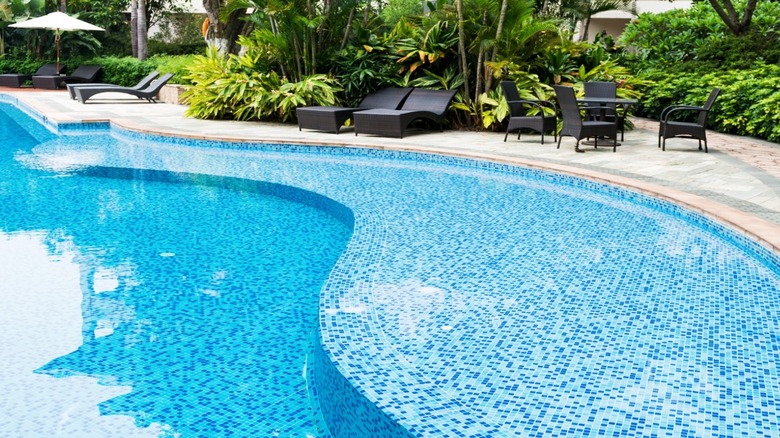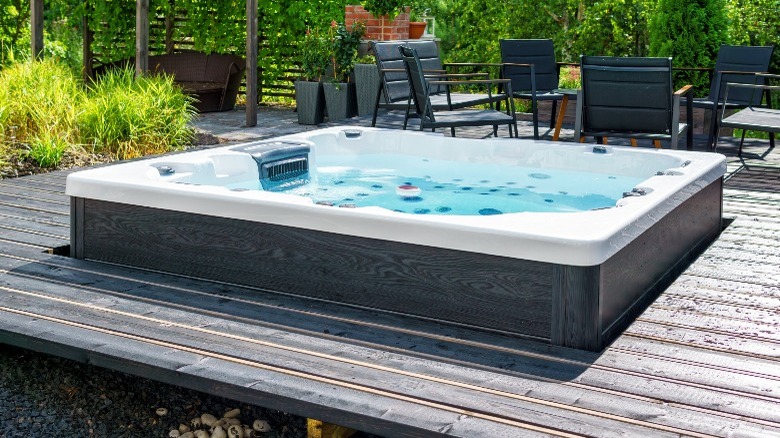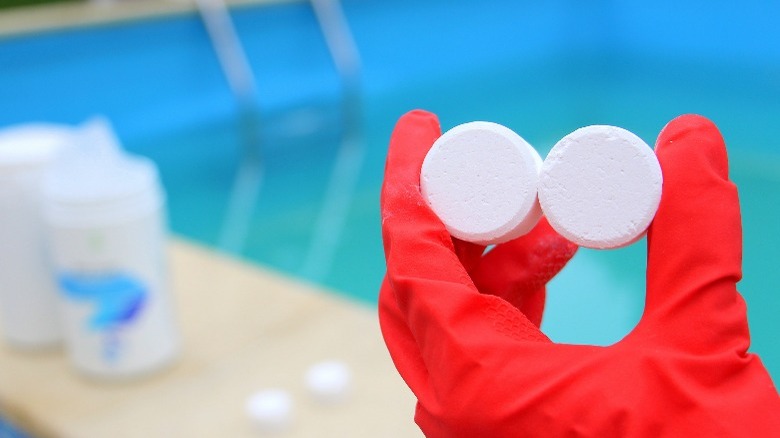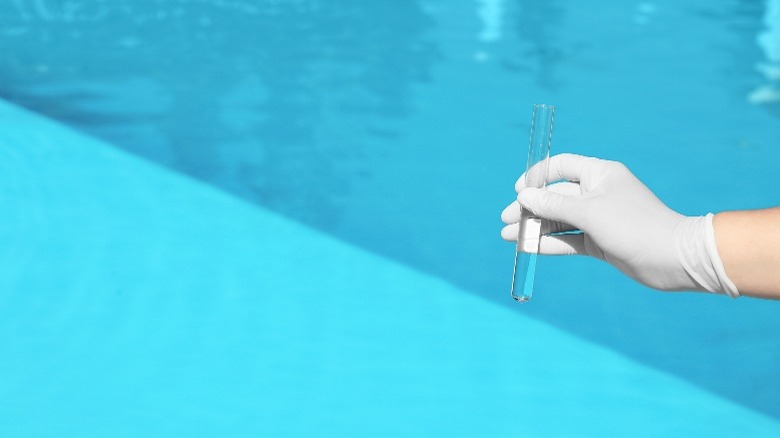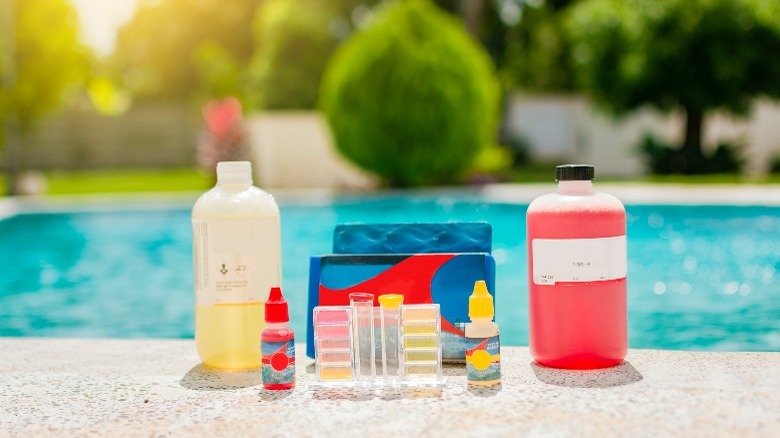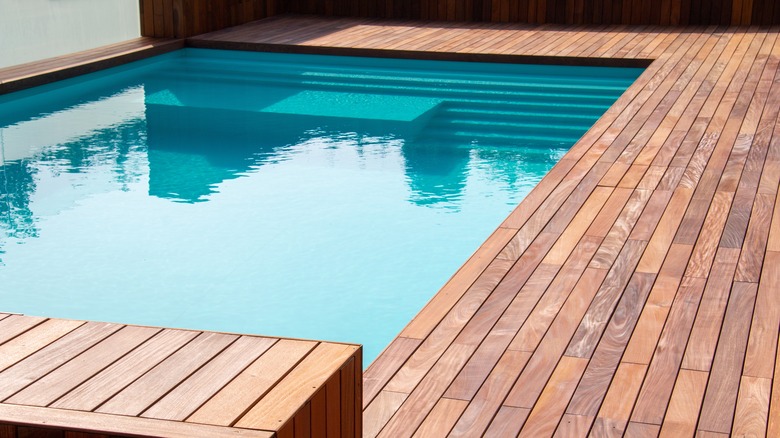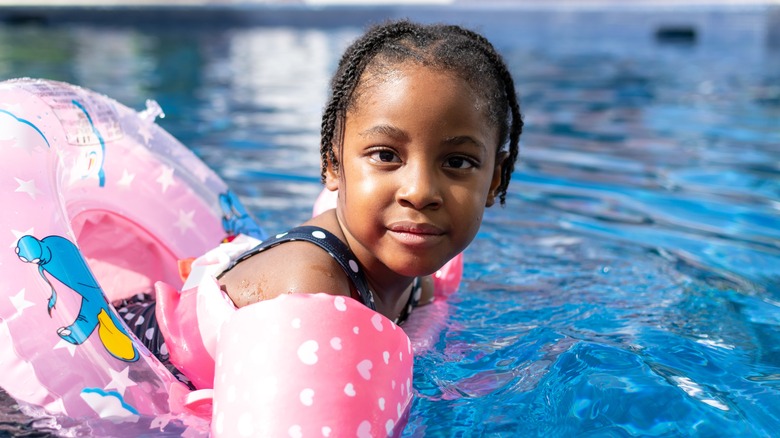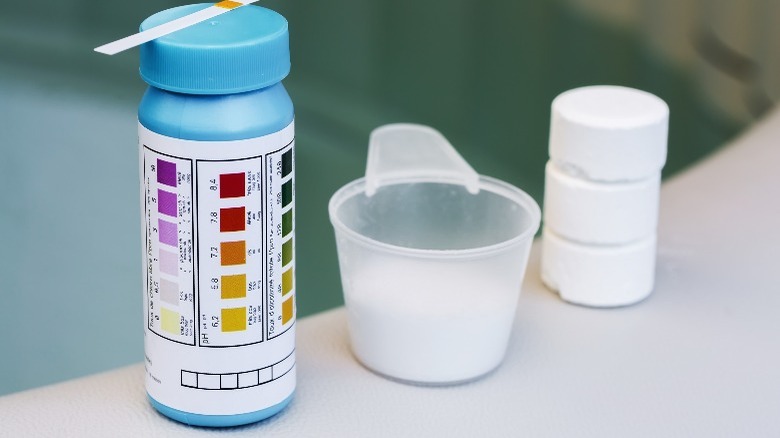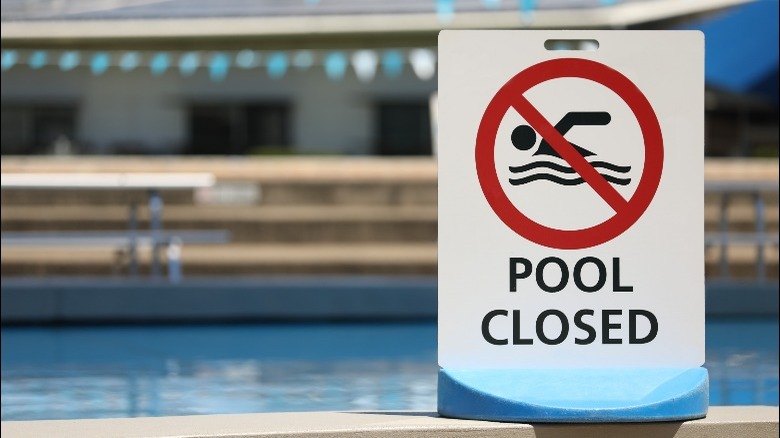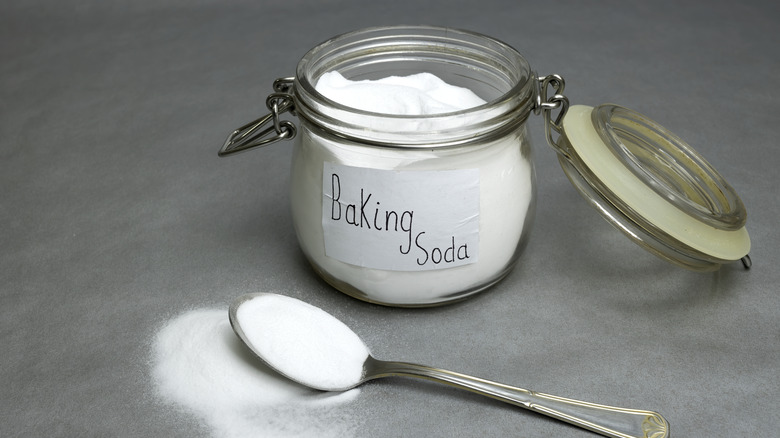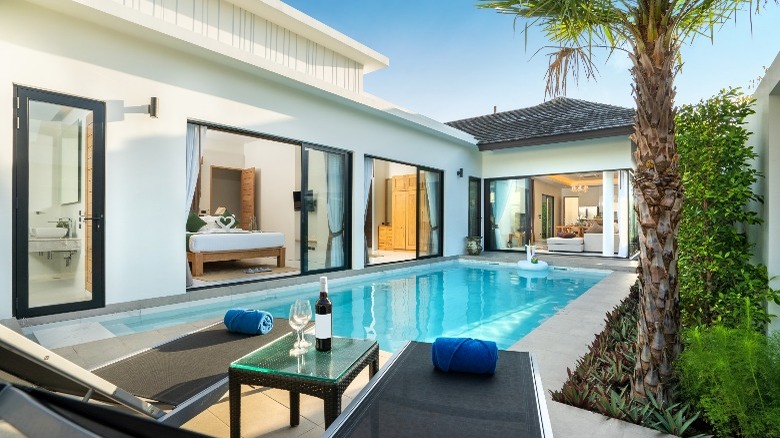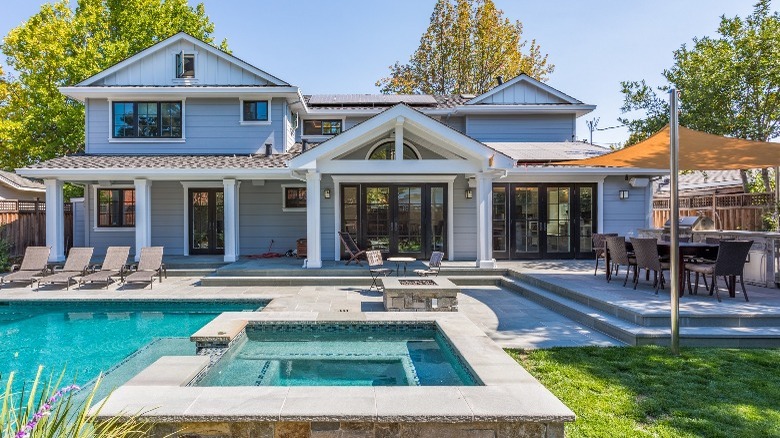Free Chlorine Vs. Total Chlorine: What's The Difference In Your Pool?
If you're a homeowner with a pool or hot tub to care for, having the right chlorine balance is vital to keeping the water sanitized and safe for people to swim or soak in. Even during the off-season, it's important to test your swimming pool often and maintain the proper chlorine levels. Otherwise, the water can start getting algae, turning the pool green, and causing bacteria to flourish. Additionally, when people use the pool, contaminants are introduced to the water, such as sweat, suntan lotion, and deodorants, to name just a few! The way you maintain a safe, immersible water zone for your guests is by keeping it sanitized and clean. Chlorine is the chemical that does this most effectively, even if you have a saltwater pool, as we will cover.
According to the American Chemistry Council, waterborne germs and bacteria from all these contaminants can cause swimmers to get sick. Some of the problems that can occur are things like swimmer's ear, diarrhea, athlete's foot, and skin irritations. This is why getting the right numbers when performing a chemical test on your pool water is so important. So let's find out about the three different types of chlorine you can use in your pool or spa water.
What is free chlorine?
The first type of chlorine we're going to talk about is essentially the most important one, and it's referred to as "free" chlorine. When you perform a chemical test on your pool water, free chlorine is the percentage of active chlorine molecules available to sanitize any contaminants entering the water, as per Forbes. Obviously, this measurement is pretty much the one that matters because if you don't have enough available chlorine in the water to kill bacteria, why would you even be using the chemical in the first place? The answer is, you wouldn't. But science has found chlorine to be the most effective sanitization method for waterborne germs, at least until we discover something better.
To find out what happens when you put chlorine in your swimming pool, ScienceDirect tells us that when the free chlorine hits the water, there's a chemical reaction that occurs when the chlorine comes into contact with organic matter (bacteria) in the water. During this reaction, chlorine breaks down the molecules and enzymes of contaminants and kills bacteria. To maintain optimal free chlorine in your pool or spa, it should consistently read between 1ppm and 3ppm [parts per million], as per SwimmingPool.com.
What is combined and total chlorine?
The next component we'll go over is typically referred to as "combined" chlorine. We learned that when chlorine comes in contact with germs and bacteria in the water, it combines and breaks down the molecular structure of the contaminants. The chlorine that has done this job is called "combined chlorine." According to Corrosionpedia, when combined chlorine occurs, it no longer has free chlorine's disinfection superpowers. More simply put, it turns Superman back into Clark Kent. Not only that, it produces a strong odor when combined chlorine levels are too high. Now we have a smelly Clark Kent, so we need to fix that.
Clear Comfort tells us that the lower our combined chlorine level is, the better the water and air quality will be for our swimmers. When you swim in a pool with a strong chemical odor, it's from the chloramines, also known as combined chlorine. But standard chemical tests only show two kinds of chlorine: free and total. The term "total" chlorine refers to the amount of free chlorine and combined chlorine together, as the total amount of chlorine in the pool. As you may have guessed, you must subtract the free chlorine from the total chlorine to get the combined chlorine levels. With this simple formula, the sum will tell you the amount of combined chlorine in your pool or hot tub.
How to collect a proper water sample to test
PoolResearch says it's important to test your swimming pool water at least once a month. There are some exceptions that require more frequent testing, like after a rainstorm or significant weather changes, after adding water to the pool, or if you notice any cloudiness or discoloration. Accuracy is of utmost importance, so you should always follow a few easy steps to ensure the best results. According to In the Swim, the first step is to circulate your pool water on the pump's high setting for a minimum of one hour before starting the actual test process. For all types of tests, you will be taking a water sample from the pool, but it's important to take the sample correctly to get the most accurate reading.
Go to the middle of the pool and get the sample from about 12 to 18 inches below the surface. You do this by holding the tube or cup upside down as you dip it below the surface to the desired level. The general idea is to retrieve a sample from as close to the center of the actual body of water as possible. Make sure you don't get near your return jets or skimmer. When you're at the level you need to be, turn your hand with the sample tube around and lift it straight up and out of the pool. If there's a lid, secure it immediately.
Different types of tests and normal results to expect
Now, depending on your test type, the way you perform the next steps will vary. In any case, follow the instructions for whatever test method you use carefully. According to Pool Research, there are three main kinds of tests. Ideally, you should test once a month with a liquid test kit or take a sample to a pool store professional. In between times, test strips are adequate. If you can afford to purchase a digital reader, this is the most accurate and straightforward testing method. For all testing equipment, store it in a dry, cool area and check expiration dates. It's also important to know there are other components to check for, in addition to the chlorine levels. The main things you're going to check for are pH balance, alkalinity, calcium hardness, and chlorine.
No matter your test method, the results should fall within a certain range. Just as crucial as chlorine, your pool's pH balance should fall in the 7.2 to 7.8 range. For liquid test kits, SwimmingPool.com says these are average numbers: total alkalinity should be between 120ppm and 150ppm. Calcium hardness, if you have a concrete pool, should be between 200ppm and 250ppm, and for a vinyl pool should be between 175ppm and 225ppm. Free chlorine should always be between 1ppm and 3ppm. Combined chlorine should be a maximum of 0.5ppm. Free bromine should be between 3ppm and 5ppm. Metals should be 0ppm, and CYA stands for cyanuric acid, which should be between 30ppm and 50ppm. Test strips are basic, but include pH, alkalinity, and chlorine. Digital testers vary, but most are comprehensive — and it does the reading for you, leaving less room for error.
What causes low free chlorine levels, and how to fix it
If your results come back with a free chlorine level below 1ppm, you may have smelly Clark Kent swimming in your pool or spa. Just kidding, but to fix that, it's probably time to shock your pool. Swim University explains that sometimes there are too many contaminants in the water for the usual free chlorine level to handle. If you have a pool party, for example, or a higher number of people in and out of the pool, or maybe you have a dog who likes to swim, these factors will reduce the available free chlorine. If a storm brings a lot of debris or rainwater into the pool, it can also cause this. The important thing to remember is that the more pollutants in the water, the lower the free chlorine levels. When they get too low, it's time to shock your pool.
Another less common cause for a low free chlorine level in outdoor pools can be related to CYA (cyanuric acid). Going back to our liquid test kit (or digital reader), we mentioned CYA levels, which can be important to know in cases where shocking the pool doesn't work. According to Sciencing, CYA works as a stabilizer for chlorine, which without CYA would lose up to 90% of its efficacy within just two hours from the UV sunlight. Using the right level of CYA can extend free chlorine life up to eight times and protects it from the sun's harmful UV rays. Dichlor and trichlor are forms of stabilized chlorine and are recommended as they contain CYA already (via Orenda Technologies). This level needs to be watched, however.
What happens if the free chlorine level is too high
InTheSwim tells us free chlorine levels that are too high can be harmful. For example, free chlorine above 5ppm can cause swimmers to have irritated, red eyes, itchy, flaky skin, and/or dry, brittle hair. When levels reach 10ppm or above, things can start to get ugly. At this level, airways and lungs can become affected, swimwear or clothing bleached out, hair can turn lovely shades of green and orange, skin can become red and start peeling, etc. Luckily, you can do things to lower it, but until it drops below 5ppm, preferably below 3ppm, do not allow anyone to enter the pool or spa.
The first thing to do is stop any chlorine that may be flowing, so if you have an automatic chlorinator, shut it down. Or, if you have a chlorine floater, remove that. If you've got more time than money, turn on the circulator or vacuum to agitate the water, and wait. Chlorine will naturally dissipate pretty quickly in the sunlight with agitation and aeration. Wait a few hours and test it again. Below 5ppm should be safe to swim for most people. If you need to use the pool and don't mind spending a little money, you can try a chlorine neutralizer called sodium thiosulfate, which will instantly reduce chlorine levels. You can also use Vitamin C or good old hydrogen peroxide, believe it or not!
What is a chlorine lock and what causes one?
Like a low free chlorine reading, a reading that shows no chlorine, zero free chlorine, or if free chlorine is vastly different from total chlorine, means you have your chlorine locked. Direct Pool Supplies explains that if you are getting a reading of no free chlorine but otherwise maintain the pool properly, oxidation has begun occurring faster than chlorine can keep up with. Standard methods like shocking or even using a salt chlorinator are no longer effective if this happens. Your pool will have a strong chlorine smell; the walls of the pool could feel slimy to the touch, you may have brown dust at the bottom that turns cloudy when disturbed, or it could even appear normal.
It is important to understand what is causing this, so it doesn't happen again. There are several possibilities, including too high of a CYA level or having too much stabilizer, according to Angie's Pool & Spa. A pH balance that's off can also be the culprit. If you have brown dust at the bottom of the pool that makes the water cloudy when disturbed, you may have a case of mustard algae. Pools and spas can also be particularly vulnerable to something called biofilm. As we spoke about earlier, sometimes a lot of rainwater or a storm that deposits a great deal of debris in the pool can cause a chlorine lock.
How to break a chlorine lock in your pool or spa
Depending on which of these things caused the lock, there may be different solutions. But Mr. Pool Man tells us that the fastest, most common method to break a chlorine lock is to attain what's called breakpoint chlorination by using a triple-shock treatment with unstabilized chlorine. You must use the right amount of unstabilized chlorine to achieve this breakpoint, and understanding the formula can be challenging. Basically, the idea is to add 10 times the amount of chlorine to the amount of combined chlorine. You can always ask a pool care professional to help with this process.
If high levels of CYA are the cause, you will have to do one of two things. The first, most cost-friendly way is to partially drain the pool or spa, preferably with a submersible pump, rather than risking your pool pump. Drain approximately 1/4 of the water out of the pool and fill it with new water from the hose. Then you'll need to circulate the water for a minimum of eight hours before you recheck your levels. Add your chlorine, and check levels to ensure the free chlorine is readable and normalizing. You can also use a CYA reducer instead, but they do cost about $125. If neither of these things works, call a professional for assistance.
What role pH plays in pool maintenance
As mentioned previously, pH balance must be maintained between 7.2 and 7.8. According to Executive Blue Pools, pH balance is the most important factor in keeping the correct chemical balance overall in your pool. When it's too low, the water is considered corrosive due to damage it can cause to pool equipment. This corrosive water also causes chlorine to destabilize, therefore reducing free chlorine levels. If the pH level is higher than 7.8, it can cause the water to become cloudy, and cause scales to form around the edges of the pool that eventually turn black. The filter can become clogged and destroyed. Not only that, but a high pH also reduces chlorine efficacy, and will require you to use far more.
Believe it or not, Arm & Hammer says you can use baking soda for pool maintenance of pH! You can buy it in large quantities for pool care, only it's referred to as sodium bicarbonate. By using this simple household product instead of commercial pool products, you'll save a lot of money. Baking soda raises the pH when it gets low and raises the alkalinity, which should be between 110ppm and 150ppm. If the alkalinity gets low, particularly at 80ppm or under, you'll add 1.5 lbs. of sodium bicarbonate per 10,000 gallons of water by merely spreading it in arcs across the surface. After it's been dispersed, turn the pool circulator on and wait at least six hours before retesting. These steps can be repeated until pH is 7.2 or above and alkalinity is at the desired level.
How to make your chlorine last longer
With so many things working against the sanitizing effects of chlorine in your pool, there are additional steps you can take with weekly and monthly pool maintenance that will boost your chlorine's performance and help it last longer. As previously discussed, use a stabilizer like CYA or pre-stabilized chlorine products that already contain CYA in correct amounts. According to Clorox, another important addition to weekly maintenance is to use an algaecide as a preventative treatment. This is said to help chlorine efficacy and extend its lasting power. A clarifier is also recommended, which allows water to stay crystal clear and reduces the workload on chlorine.
In the Swim suggests using alternative sanitizing methods as well, such as installing a mineral purification system. They also recommend using an enzyme-based product to eliminate organic contaminants like sweat, sunscreen, and body oils. All of these products are designed to improve the effectiveness of chlorine and maintain a healthy, crystal-clear pool or spa. It would help if you also kept your pool water filtered and well circulated at all times. Test for the basics at least once a week, more often when usage increases, a storm comes through, or whenever you see any warning signs. Maintaining vigilance with pool care and proper, consistent testing yields a longer-lasting chlorine balance and a healthier swimming environment.
Chlorine and chemical safety
Last but not least, let's go over some chemical safety tips for handling chlorine and other pool products. According to Luxury Pools + Outdoor Living, chlorine should not be breathed in or come in contact with your skin, so wear a mask and gloves. As we all know, it can also bleach clothes (and even hair!), so wear old clothing when handling chlorine. Do not mix different kinds of chlorine products or chlorine with any other chemicals.
American Pool says to store pool chemicals in a cool, dry, and ventilated area, away from children and pets. Keep all products in original containers, and don't stack them. And finally, store chlorine separately from acids, and discard unused chemicals after two years. As long as you take regular tests and properly maintain your home swimming pool or spa, your family and guests will enjoy taking a dip practically anytime they like. Just be sure not to invite Superman (wink-wink.)
